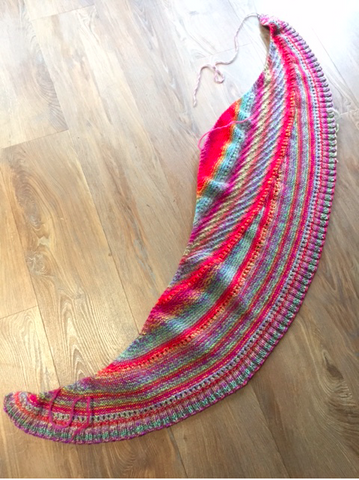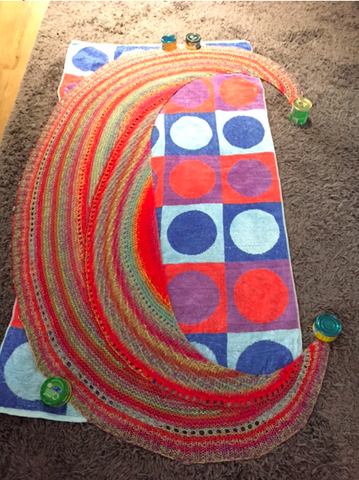Shara Lambeth is our expert at Crumbz Craft when it comes to blocking – here’s what she had to say about it.
When did you first come across blocking Shara?
People have been blocking for probably as many years as they’ve been knitting, but it’s more popular and well known now. About 7 or 8 years ago it became the ‘in’ thing and everyone began talking about it. As soon as I tried it and realized what an amazing difference it made to my finished work, that was it, I was hooked.
Here are 3 snapshots of blocking my Cleckheaton Crescent Shawl
Before...

During...

and After

Does blocking work for crocheted items as well as knitted items?
Absolutely. When you block, it relaxes the fibres and sets the stitches into the position they should be in.
Are there different types of blocking?
Yes there are – there are different methods and different levels. The above shawl for example needed an aggressive blocking – where I gave it a gentle wash, removed as much excess water as I could by wrapping it in a towel (and standing on the towel!!) then stretched it out as far as it would go, and pinned it. It had been knitted in a crescent shape so it had gathered, especially where the stitches had increased or decreased.
The good news is it will only stretch into the shape it is meant to be. But be careful – because whatever shape you block it into when wet, will be the exact same shape when dry. So if you have one arm set out longer than the other or slightly scued, that is exactly what you’ll end up with when it’s dried. For good! So it’s really worth taking the time to be precise and patient. Spend a good 15-20 minutes blocking your piece.
What happens when you wash your blocked item next time around?
It won’t stay in exactly its blocked shape, but neither will it go back to it’s pre-blocked state. Do a gentle blocking to get it back into the right shape. Only re-block each time if it needs it.
So, how do you block something?
Here are three different types of blocking:
1. Initial Wet block (an aggressive block)
Gently soak your item in tepid water
Gather your item gently out of its bath
Roll it tightly in a towel or give it a spin in the washing machine on a spin only cycle, in a garment bag or pillow slip.
Stretch it to its desired shape
Pin it to a towel or a mat.
Let it dry, turning it over if it is double sided, like a garment
When it dries, the stitches are set in place.
2. Steam block (good for highly textured fabric, like cables or bobbles)
No soaking, just ‘push’ it into shape as the steam from the steam iron goes into the item (hover the iron over your item, do not let it come into contact).
Some yarns don’t want to be wet, so a steam block is perfect.
3. Spray with water (good for a gentle blocking)
No soaking, just push into shape and pin it as you spray with water.
Shara’s Blocking Top Tips
- Take the extra time to get the exact shape you want.
- If blocking a woolen item, gather up carefully, so as not to stretch your item
- Remember - It’s very hard to block something smaller!
- You can refresh items with a blocking that have stretched out over time, (especially plant based fabrics or cotton) after a bath they will shrink back to their original size, but wool doesn’t work this way.
- Be careful with detergents, don’t use soap – I use a wool wash called Eucalan which doesn’t require rinsing (eucalyptus and lanolin)
Happy blocking everyone :-)
